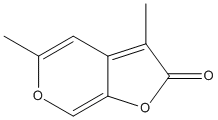Karrikin-3
General
Type : Plant hormone || Karrikin || Butenolide || Natural || Strigolactone receptors ligand
Chemical_Nomenclature : 3,5-dimethylfuro[2,3-c]pyran-2-one
Canonical SMILES : CC1=CC2=C(C(=O)OC2=CO1)C
InChI : InChI=1S\/C9H8O3\/c1-5-3-7-6(2)9(10)12-8(7)4-11-5\/h3-4H,1-2H3
InChIKey : LVIAGZUAWKSKRF-UHFFFAOYSA-N
Other name(s) : 3,5-Dimethyl 2H-Furo[2,3-c]pyran-2-one, SCHEMBL3849796, ZINC65740533

Target
Families : RsbQ-like
References (3)
| Title : Regulation of seed germination and seedling growth by chemical signals from burning vegetation - Nelson_2012_Annu.Rev.Plant.Biol_63_107 |
| Author(s) : Nelson DC , Flematti GR , Ghisalberti EL , Dixon KW , Smith SM |
| Ref : Annu Rev Plant Biol , 63 :107 , 2012 |
| Abstract : Nelson_2012_Annu.Rev.Plant.Biol_63_107 |
| ESTHER : Nelson_2012_Annu.Rev.Plant.Biol_63_107 |
| PubMedSearch : Nelson_2012_Annu.Rev.Plant.Biol_63_107 |
| PubMedID: 22404467 |
| Title : Identification of alkyl substituted 2H-furo[2,3-c]pyran-2-ones as germination stimulants present in smoke - Flematti_2009_J.Agric.Food.Chem_57_9475 |
| Author(s) : Flematti GR , Ghisalberti EL , Dixon KW , Trengove RD |
| Ref : Journal of Agricultural and Food Chemistry , 57 :9475 , 2009 |
| Abstract : Flematti_2009_J.Agric.Food.Chem_57_9475 |
| ESTHER : Flematti_2009_J.Agric.Food.Chem_57_9475 |
| PubMedSearch : Flematti_2009_J.Agric.Food.Chem_57_9475 |
| PubMedID: 19785418 |
| Title : Karrikins: A New Family of Plant Growth Regulators in Smoke - Chiwocha_2009_Plant.Sci_177_252 |
| Author(s) : Chiwocha SDS , Dixon KW , Flematti GR , Ghisalberti EL , Merritt DJ , Nelson DC , Riseborough JAM , Smith SM , Stevens JC |
| Ref : Plant Sci , 177 :252 , 2009 |
| Abstract : Chiwocha_2009_Plant.Sci_177_252 |
| ESTHER : Chiwocha_2009_Plant.Sci_177_252 |
| PubMedSearch : Chiwocha_2009_Plant.Sci_177_252 |
| PubMedID: |